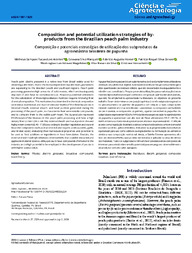Composition and potential utilization strategies of by-products from the Brazilian peach palm industry.
Composition and potential utilization strategies of by-products from the Brazilian peach palm industry.
Author(s): ARANTES, M. S. T.; MARQUES, G. S.; HANSEL, F. A.; ZANONI, P. R. S.; MAGALHAES, W. L. E.; SILVA, V. R. da; HELM, C. V.
Summary: Peach palm (Bactris gasipaes) is a native tree from Brazil widely used for obtaining palm heart. Due to the increasing interest in palm heart, plantations are expanding to the Brazilian South and Southeast regions. Peach palm processing generates high amounts of solid wastes, which are inadequately disposed of and have no consolidated use. Proposing potential utilizations for the valorization of these lignocellulosic matrices requires knowing their chemical composition. This work aimed to determine the chemical composition (at mineral, nutritional, and macromolecular levels) of the three by-products (internal sheath, external sheath, and basal portion) generated during the processing of the peach palm, to characterize their semi-volatile compounds, and to compare them to the edible palm heart. The by-products represent 83.6% (w/w) of the biomass in the peach palm processing and have a high dietary fiber content (59.2 - 68.1%). Internal sheath and basal portion showed high protein content (8.40 - 11.8%) according to Brazilian legislation and several bioactive compounds such as myo-inositol and organic acids (succinic, gallic, and linoleic acids), indicating their nutraceutical properties and potential to be used as food additives or ingredients in food formulation. Besides, the external sheath had high cellulose content (39.6%) that could be extracted and applied in material science. All by-products have compounds of interest to the industry and a high potential to be employed in the development of products with higher added value.
Publication year: 2024
Types of publication: Journal article
Unit: Embrapa Forestry
Keywords: Bactris Gasipaes, Bioactive compound, Biorefinery, Biorrefinaria, Composto bioativo, Palmito, Peach palm, Pupunha, Resíduos, Waste
Observation
Some of Embrapa's publications are published as ePub files. To read them, use or download one of the following free software options to your computer or mobile device. Android: Google Play Books; IOS: iBooks; Windows and Linux: Calibre.
Access other publications
Access the Agricultural Research Database (BDPA) to consult Embrapa's full library collection and records.
Visit Embrapa Bookstore to purchase books and other publications sold by Embrapa.

